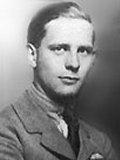|
Alfred
Atkey


Name: Alfred Clayburn
Atkey
Country: Canada
Rank: Captain
Service: Royal Flying Corps Royal Air Force
Units: 18, 22
Victories: 38
Date Of Birth: August 16, 1894
Place of Birth: Toronto, Ontario
Date Of Death: February 10, 1971
Place of Death: Toronto, OntarioIn 1906, Alfred Atkey's family left Toronto to pioneer western
Canada. From Minebow, Saskatchewan, Atkey returned to Toronto as a
journalist for the Toronto Evening Telegram. On October 19, 1916,
he enlisted in the Royal Flying Corps as a probationary Second
Lieutenant. By September 1917, he was a bomber pilot assigned to
18 Squadron, flying the D.H.4, and on his way to becoming the
highest scoring two-seater pilot of World War I. In his fitness
reports, he was described as an "expert in gunnery, bombing,
photography, reconnaissance."
In May of 1918, Atkey assumed command of "A" flight in 22
Squadron. He switched from flying the D.H.4 to the Bristol F.2B.
For his gunner and observer, he chose Lieutenant C.G. Gass.
Together, they were a deadly team, shooting down 29 enemy aircraft
in less than one month. On one occasion, their "Brisfit" was so
badly shot up that Gass had to crawl out onto the lower wing to
counterbalance the aircraft so that Atkey could fly it back to
base.I n an epic dogfight known as "Two Against Twenty," Atkey and
Gass, together with John Gurdon and his observer, John Thornton,
encountered 20 German scouts during the evening of May 7, 1918. In
the battle that followed, Atkey and Gass shot down five enemy
aircraft while Gurdon and Thornton shot down three. Two days
later, Atkey and Gass again shot down five enemy aircraft in one
day.
Military Cross (MC)
"For conspicuous gallantry and devotion to duty. When engaged on
reconnaissance and bombing work he attacked four scouts, one of
which he shot down in flames. Shortly afterwards he attacked four
two-seater planes, one of which he brought down out of control. On
two previous occasions his formation was attacked by superior
numbers of the enemy, three of whom in all were shot down out of
control. He has shown exceptional ability and initiative on all
occasions." MC citation, London Gazette, June 22, 1918
Military Cross (MC) Bar
"For conspicuous gallantry and devotion to duty. During recent
operations he destroyed seven enemy machines. When engaged with
enemy aircraft, often far superior in numbers, he proved himself a
brilliant fighting pilot, and displayed dash and gallantry of a
high order." MC Bar citation, London Gazette, September 16, 1918
|
